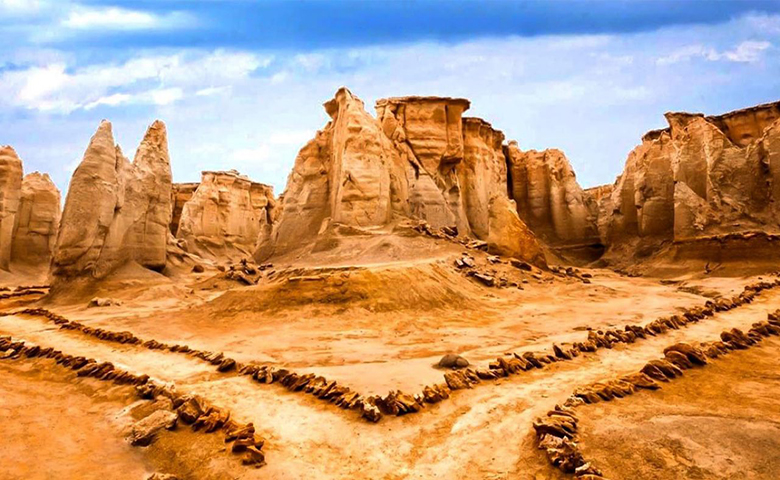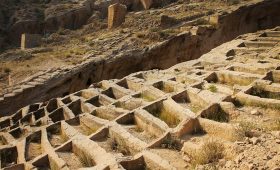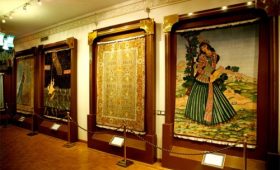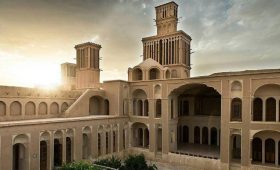The Valley of Stars is one of the unique geological phenomena that are in the list of seven wonders of Qeshm, and with an age of more than two million years, it dazzles the eyes of every viewer. This valley, the number of examples of that is not many in the world, is one of the mysterious and interesting attractions, which includes sharp cones, huge columns and high walls. This natural phenomenon is formed due to erosion caused by seasonal rains, surface water and strong winds, and there are many layers and holes inside each column of this valley that air easily penetrates into. These features of Star Valley have made this valley to be registered as a part of Qeshm Geopark in the UNESCO heritage. It is interesting to know that Qeshm Geopark is the only Geopark in the Middle East.
The unique beauty of Star Valley has made it one of the most popular sights in Qeshm and many tourists visit it throughout the year.
Dera Setargan is one of the most popular geosites in Qeshm Geopark, which the locals call “Staleh Kefta” which means “Fallen Star”. In fact, the natives of this region believe that the impact of a star (meteorite) on the earth caused stones and soil to be thrown into the air, as a result of which this valley was formed, and that is why they called it the fallen star.
Star Valley is one of the most popular geosites in Qeshm Geopark. The fact is that this unique geosites was created due to the heterogeneous action of erosive factors such as water, wind and weight pressures on different layers of the earth. The impact of these factors in the more resistant sectors has been less and as a result remained unchanged; while the loose and soft parts affected by erosion have been destroyed. This valley dates back to the Cenozoic geological period, about two million years ago. The geometric shapes of the Star Valley are made of sand, stone and lime cement.
Strange shapes in the valley of stars
The walls of this valley are composed of two completely different materials, which include a thick and almost soft layer of cream to light gray color below and a thin and hard layer of white to dark gray color on it.
The bottom loose layer is quickly destroyed against erosion factors; if the upper layer is hard and acts as a shield for the lower layer, it protects it from erosion. In the places where the top layer has been lost or a gap has been created, the erosion speed has increased and has led to the formation of small gaps and valleys.
Columns can be seen in some parts of the valley that are needle-shaped and narrow. The cause of this issue can be seen as the rotating and flooding movement of seasonal rainwater around the columns or old walls. Besides, the presence of a resistant cap on part of the bottom layer has caused this part to be preserved in the form of a column; although the surrounding area has been destroyed due to the lack of a protective layer.
In this way, it can be concluded that the layers in this valley are very sensitive and fragile, and even human weight on them can reduce the resistance of the upper hard layer, create very small and narrow seams in their structure, and even lead to the sudden collapse of these layers. Come For this reason, walking on these layers is very dangerous and will have irreparable effects on this unique geological heritage.
Due to the loose nature of the layers, it is possible that after heavy rainfall, significant changes will occur in the morphology of the valley.
In some parts and holes of the valley of stars, red soil can be seen, which may evoke the planet Mars in the mind and have a double attraction for those interested.
Seashells have been observed on top of the hard rock and sand sculptures, indicating that this area was under the sea in the distant past.
Setargan valley is one of Hormozgan’s sightseeing places, that is located on the north side of Qeshm Island and near a village called Barke Khalaf. If you go from Qeshm city to the southern coast of the island, it is located five kilometers from the southern coast of the island, and you can see the most beautiful effects of erosion on the island in the north of this village.
According to the legends of the local people of Qeshm, Star Valley is the place where goblins and ghosts live at night. Many people believe that the strange sounds that can be heard from this valley at night are due to the presence of these creatures, and therefore they do not recommend tourists to enter the Valley of Stars at night.
Geological researchers believe that the cause of these sounds is the winding of the wind in the openings and holes of the rocks, which produces a special sound when passing through these corridors and columns.
Star Valley, with its magnificent and mysterious rocks, brings silence and peace to tourists who can be immersed in this masterpiece of creation for hours. Moreover, on moonlit nights, silence is everywhere and just like the desert you feel, the stars are within reach, the sky and bright stars above this valley seem close to the earth. The Valley of Stars is really full of stars, and on nights when there is no cloud or dusty weather, there are so many stars that you feel you can pick them with your hands.
This is not the only similarity of Star Valley to the desert, and most of its statues are made of earth and evoke the Klots of Lut desert. Contrary to the belief of the people who do not go to the valley at night, tourists can experience very pleasant nights in this valley.
Touring In Star Valley, the traffic path is marked with pebbles so you don’t get lost. There are narrow and wide paths in the corners and sides of the valleys and columns, which amaze every viewer with their special order. If you continue along the stone path, you will reach two large rocks at the entrance of the valley that look like a big gate.
The statues of this valley appear in various forms, from elephants and crocodiles to eagles, etc., which are worth seeing. Also, long columns, blades and sharp cones stand out in the Valley of Stars, and the traces of erosion on them are quite evident. There are also seams in some of these walls that have an attractive yet scary appearance and make you lose your sight.
Along the way, you will reach the roof of the valley, where you can watch a different view of the valley of stars and enjoy all this beauty. Along with seeing the wonders of the valley, capture these pure moments to be with you forever. If you go to the top of the valley, the whole valley will be under your feet and you can take wonderful photos.
Stone Museum: This museum is located in the building of Voorman Dere, and by visiting it; tourists can learn about the rocks and minerals of Qeshm, Hormoz and Hamza islands and get more information about the geology of the region. 48 samples of rocks, minerals and fossils from Hengam, Hormuz and Lark islands are displayed in the Stone Museum.
Visiting Barka Khalaf village: Barka Khalaf village that is known as the cleanest village in Qeshm is located near Dera Setargan. Garbage is hardly found in the streets of this village; because local women clean the entire village once or twice a week. In addition to the cleanliness of the streets and houses of the village, the collection of traditional and colorful clothes made by the women of the island is kept in a corner of the village, which is not only sold, but also available for rent.
If you are interested in henna decorations on the body, in this village you can go to female artists who will draw beautiful mental patterns for you.
Camel riding: In the area of Star Valley, there are a number of camels that you can enjoy camel riding in this valley.




